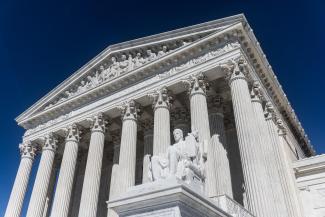The Supreme Court heard two related cases this term that are not about pollution or natural resources but that nonetheless could undermine one of President Biden’s biggest environmental efforts, dubbed Justice40. In Executive Order 14008, the president requires that 40 percent of the benefits of new clean energy and transportation and similar programs flows to “disadvantaged communities.” This initiative is designed to “help confront decades of underinvestment in disadvantaged communities and bring critical resources to communities that have been overburdened by legacy pollution and environmental hazards.”

Identifying those communities is the tricky part. Environmental justice advocates explain that race is the best predictor for communities that are burdened with a disproportionate amount of harmful pollution—because of the history of racist siting, housing, transportation, and other practices. And they have a point.
But several cases brought over the last year have created a tough litigation outlook for programs that provide benefits based on race. Those cases grew out of provisions in the American Rescue Plan Act of 2021 which prioritized small business grants for disadvantaged applicants and provided debt relief for “socially disadvantaged farmer[s] or rancher[s]” through a loan program. For both, the term “disadvantaged” was defined to include groups that have been subject to racial discrimination because of their membership in a racial or ethnic group.
Courts have been striking down those provisions under the equal protection doctrine, under which race-based programs are presumptively illegal. The government may be able to defend a race-based policy if it can show that it is necessary to achieve a compelling state interest and that the remedy is narrowly tailored to advance that interest. However, it is hard to win such cases.
For example, in Vitolo v. Guzman, in the Sixth Circuit, a restaurant owner won his challenge to the use of race to prioritize small business grants. The government argued that the program was set up to remediate past governmental discrimination. But the court held that the discrimination the government was seeking to address was too generalized and that the government would need to show instead that its policy focuses on a specific act of past discrimination, which was intentional, and which was committed by the government.
In another set of cases—this time about the program directed at helping farmers and ranchers—courts in Texas, Tennessee, and Florida enjoined the Department of Agriculture from disbursing the funds. In passing the statute, Congress documented its own discrimination against farmers of color. But that has not passed muster either.
In August, Congress passed the Inflation Reduction Act, repealing the farm loan assistance program. In its place, the new law provides funding for farmers and ranchers who “have experienced discrimination prior to January 1, 2021, in Department of Agriculture farm lending programs.”
Which brings us to the two cases at the Supreme Court. Suits against Harvard and the University of North Caroline are weighing whether those schools can consider race as one factor among many others in admissions decisions. The schools argue that they will not be able to achieve their goals of a diverse student body without that factor. But the conservative justices made clear at argument that they were concerned about the alleged discrimination against White and Asian students. Justice Ketanji Brown Jackson rejoined by pointing to the contradiction of plaintiffs’ position, which would allow one person to argue that the legacy of his family members in North Carolina attending UNC should be considered in admissions, while another person whose family never attended because of slavery in North Carolina could not provide his family background for consideration. As she explained to the plaintiffs’ attorney, “Precisely because it relates to race, I think you might have an equal protection problem.”
Last year, the White House Council on Environmental Quality released a draft screening tool for identifying communities that should receive the benefits of the Biden initiative. It drew the ire of environmental justice advocates for leaving race out of the analysis.
In November, after extensive stakeholder engagement, the council released its new “Climate and Economic Justice Screening Tool.” The method still does not use race to determine if a location is “disadvantaged,” but instead looks at local risks presented by the changing climate, transportation barriers, lack of green space, lack of indoor plumbing, redlining data, legacy pollution, health factors, and water pollution. The tool then displays demographic information about the race and age of the people that live in each census tract. The tool also includes Alaskan Native Villages and Federally Recognized Tribes as disadvantaged communities. With these changes, it will be very interesting to see how this tool is used and whether challenges flow.
This blog originally appeared in the January/February 2023 issue of The Environmental Forum and is reprinted with permission.
